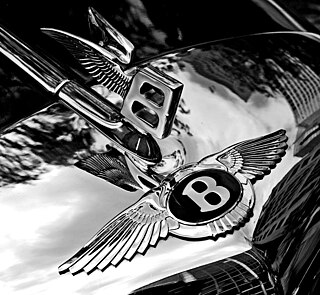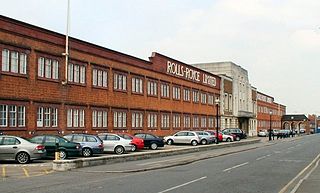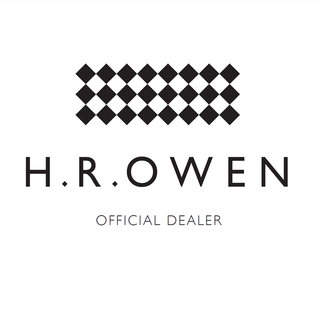
Bentley Motors Limited is a British manufacturer and marketer of luxury cars and SUVs, and a subsidiary of the Volkswagen Group since 1998.

Charles Stewart Rolls was a Welsh motoring and aviation pioneer. With Henry Royce, he co-founded the Rolls-Royce car manufacturing firm. He was the first Briton to be killed in an aeronautical accident with a powered aircraft, when the tail of his Wright Flyer broke off during a flying display in Bournemouth. He was aged 32.

Fulham is an area of the London Borough of Hammersmith and Fulham in southwest London, England, 3.6 miles (5.8 km) southwest of Charing Cross. It lies on the north bank of the River Thames, between Hammersmith and Kensington and Chelsea, facing Wandsworth, Putney and Barn Elms, with the London Wetland Centre in Barnes.

Sir Frederick Henry Royce, 1st Baronet, was an English engineer famous for his designs of car and aeroplane engines with a reputation for reliability and longevity. With Charles Rolls and Claude Johnson, he founded Rolls-Royce.

D. Napier & Son Limited was a British engineering company best known for its luxury motor cars in the Edwardian era and for its aero engines throughout the early to mid-20th century.

H. J. Mulliner & Co. was a well-known British coachbuilder operating from Bedford Park, Chiswick, West London. The company which owned it was formed by H J Mulliner in 1897 but the business was a continuing branch of a family business founded in Northampton in the 1760s to hire out carriages. In December 1909 the controlling interest in this company passed to John Croall & Sons of Edinburgh. Croall sold that interest to Rolls-Royce in 1959.

Walter Owen Bentley, MBE was an English engineer who founded Bentley Motors Limited in London. He was a motorcycle and car racer as young man. After making a name for himself as a designer of aircraft and automobile engines, Bentley established his own firm in 1919. He built the firm into one of the world's premier luxury and performance auto manufacturers, and led the marque to multiple victories at the 24 Hours of Le Mans. After selling his namesake company to Rolls-Royce Limited in 1931, he was employed as a designer for Lagonda, Aston Martin, and Armstrong Siddeley.

The Rolls-Royce Silver Ghost name refers both to a car model and one specific car from that series.

Mulliner Park Ward was a bespoke coachbuilder in Hythe Road, Willesden, London UK.
Park Ward was a British coachbuilder founded in 1919 which operated from Willesden in North London. In the 1930s, backed by Rolls-Royce Limited, it made technical advances which enabled the building of all-steel bodies to Rolls-Royce's high standards. Bought by Rolls-Royce in 1939, it merged with H. J. Mulliner & Co. in 1961 to form Mulliner Park Ward.

Rolls-Royce was a British luxury car and later an aero-engine manufacturing business established in 1904 in Manchester, United Kingdom by the partnership of Charles Rolls and Henry Royce. Building on Royce's reputation established with his cranes they quickly developed a reputation for superior engineering by manufacturing the "best car in the world". The First World War brought them into manufacturing aero-engines. Joint development of jet engines began in 1940 and they entered production. Rolls-Royce has built an enduring reputation for development and manufacture of engines for defence and civil aircraft.

Hooper & Co. was a British coachbuilding business for many years based in Westminster London. From 1805 to 1959 it was a notably successful maker, to special order, of luxury carriages both horse-drawn and motor-powered.
The Rolls-Royce 30 hp was one of four cars to be produced as a result of an agreement of 23 December 1904 between Charles Rolls and Henry Royce. Badged as a Rolls-Royce, the 30 hp was produced during 1905 and 1906 by Royce's company, Royce Ltd. at its factory in Cooke Street, Hulme, Manchester. It was sold exclusively by Rolls' motor dealership, C.S.Rolls & Co., at a price of GBP 890. The engine was exhibited at the Paris Salon in December 1904, along with the 10 hp, 15 hp and 20 hp models.

Freestone and Webb were English coachbuilders who made bodies for Rolls-Royce and Bentley motor cars but also built bodies on other chassis including Alfa Romeo, Packard, and Mercedes-Benz.

H.R. Owen is a luxury motor dealer in Britain, and one of the world's largest retailers in Rolls-Royce, Bentley, Lamborghini and Bugatti brands. The company is headquartered in London, and operates 14 sales franchises and 17 aftersales franchises.

Barker & Co. was a coachbuilder, a maker of carriages and in the 20th century bodywork for prestige cars.
The automotive industry in Massachusetts refers to a period of time from 1893 to 1989 when automobiles were manufactured in the Commonwealth of Massachusetts commercially. During this time, the state produced more automobiles than Detroit, Michigan. During the 20th century, General Motors and the Ford Motor Company were producing automobiles at the Framingham Assembly and Cambridge Assembly, respectively.
Joseph Cockshoot was an English coachbuilder and car dealer based in Manchester.
Claude Watney was a British brewery director and motor dealer.














